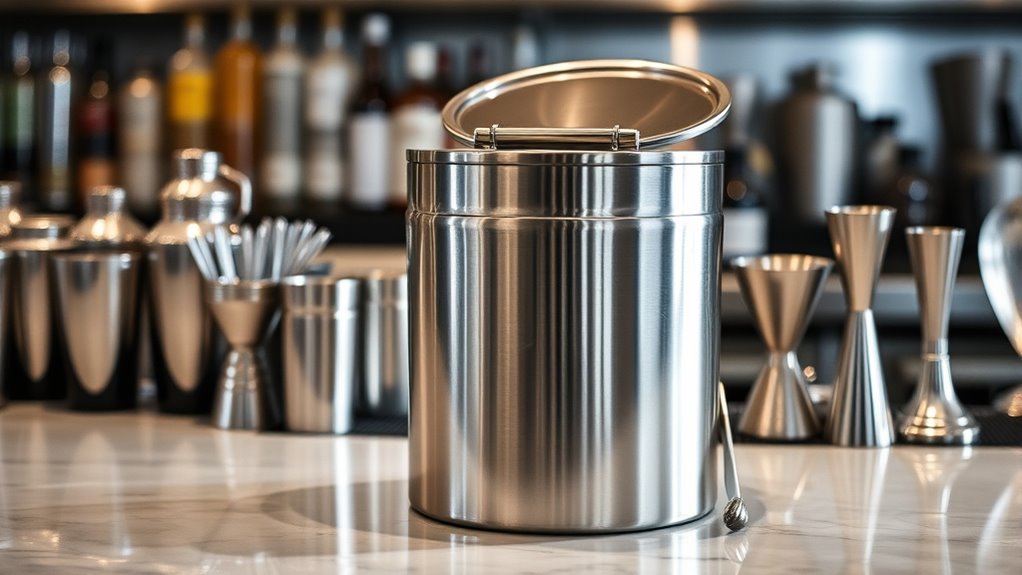In bars and kitchens, it’s vital to dispose of sharps like needles in approved, puncture-resistant containers marked with biohazard symbols. Never throw used sharps in regular trash or recycling bins. Keep disposal containers easily accessible, and handle full ones with care to prevent injuries. Follow local regulations and use authorized disposal services for safe removal. Continuing will provide you with essential safety steps to guarantee proper sharps management and protect everyone around you.
Key Takeaways
- Use designated, puncture-resistant sharps containers marked with biohazard symbols in all areas handling needles.
- Never dispose of sharps in regular trash; always place them immediately into approved containers.
- Keep sharps containers accessible and secure to prevent accidental injuries and cross-contamination.
- Follow local regulations and collaborate with authorized disposal services for full container collection.
- Educate staff on proper sharps handling, container use, and safety protocols to maintain a safe environment.

Have you ever wondered what the safest way to dispose of used needles and other sharp medical tools is? Ensuring needle safety is essential, especially in environments like bars and kitchens where accidental injuries can happen if sharps aren’t handled properly. The key to safe disposal starts with using the right disposal containers. These containers are specifically designed to contain sharps securely, preventing accidental needle sticks and reducing the risk of injury or infection. When you’re finished with a needle or any sharp object, never toss it into regular trash or recycling bins. Instead, you should place used sharps directly into approved, puncture-resistant disposal containers, which are often made of sturdy plastic with a secure, leak-proof lid. Proper sharps handling is a critical component of workplace safety, helping to prevent exposures and injuries. Using proper disposal containers is more than just a safety measure; it’s a responsibility that protects everyone around you. These containers are clearly marked with biohazard symbols or labels indicating they’re meant for sharps, so there’s no confusion about what they contain. When selecting a disposal container, guarantee it’s specifically designed for sharps and that it’s durable enough to prevent leaks or punctures. It’s best to keep these containers easily accessible in areas where sharps are used, so you don’t have to carry used needles or blades across the premises, reducing the chance of accidental injury. Once a disposal container is full, it needs to be handled with care. Never try to reopen or empty it yourself; instead, follow your local regulations for proper disposal. Many communities have designated collection sites or authorized medical waste disposal services that accept these containers. Some establishments partner with waste disposal companies that have trained personnel to pick up and safely remove sharps containers, ensuring that the materials are disposed of in compliance with safety standards. Remember, proper disposal isn’t just about avoiding injuries; it’s about protecting the environment and public health by preventing contaminated sharps from ending up in places they shouldn’t be. In workplaces like bars and kitchens, where quick turnover and convenience are essential, it’s imperative to have clear protocols for sharps disposal. Educate staff on the importance of needle safety and the correct use of disposal containers. Make sure everyone understands that no sharps should be left lying around or thrown in general trash. By maintaining a strict policy and using appropriate disposal containers, you minimize risks and promote a safer environment for staff and patrons alike. Proper sharps disposal isn’t just a regulatory requirement; it’s a critical safety practice that safeguards everyone involved.
Frequently Asked Questions
Are There Specific Disposal Regulations for Sharps in Different States?
Yes, you need to follow state-specific regulations for sharps disposal to guarantee disposal compliance. Each state has its own rules about how you must handle, package, and dispose of sharps, so it is crucial to check local regulations. Failing to comply can lead to fines or safety hazards. Stay informed about your state’s guidelines to safely manage sharps, protect your staff, and stay within legal requirements.
How Often Should Sharps Containers Be Replaced in Bars and Kitchens?
You should replace sharps containers in bars and kitchens when they reach their maximum lifespan or become nearly full. The disposal frequency depends on usage, but generally, it’s best to change the container before it overflows to guarantee safety. Regularly monitor the sharps container’s lifespan and fill level, and dispose of it promptly once it’s full or at the recommended interval to prevent accidents and maintain compliance.
What Training Is Required for Staff Handling Sharps Disposal?
You need to provide staff with proper training on sharps safety and disposal protocols to guarantee safe handling. This includes teaching them how to correctly use, handle, and dispose of sharps containers, as well as recognizing potential hazards. Regular training sessions help reinforce best practices, reduce risks of injury or contamination, and ensure compliance with health regulations. Keep training updated and document attendance for accountability and ongoing safety improvements.
Can Sharps Be Reused After Proper Sterilization?
No, sharps shouldn’t be reused after proper sterilization. Sharps sterilization aims to eliminate bacteria and viruses, but reusable sharps still pose risks of damage or contamination. Using disposable sharps is safer and reduces infection risks. If you handle sharps regularly, ensure staff are trained on proper disposal and sterilization procedures, but always use single-use sharps for safety and compliance.
What Are the Costs Associated With Professional Sharps Disposal Services?
You’ll find that professional sharps disposal services typically involve costs like a thorough cost analysis and flexible service contracts. These expenses cover safe collection, transportation, and disposal, guaranteeing compliance and safety. The costs can vary based on volume, frequency, and your specific needs. By investing in these services, you guarantee a secure, compliant environment while simplifying waste management. It’s a smart choice for maintaining safety standards efficiently and effectively.
Conclusion
Remember, proper sharps disposal isn’t just a good idea—it’s a must. You don’t want to open a can of worms by neglecting safety protocols. Always use designated containers, stay vigilant, and follow your local guidelines. When you handle sharps responsibly, you’re not only protecting yourself but also safeguarding your team and customers. Keep your environment clean and safe—after all, a stitch in time saves nine. Stay cautious and dispose of sharps properly every time.









